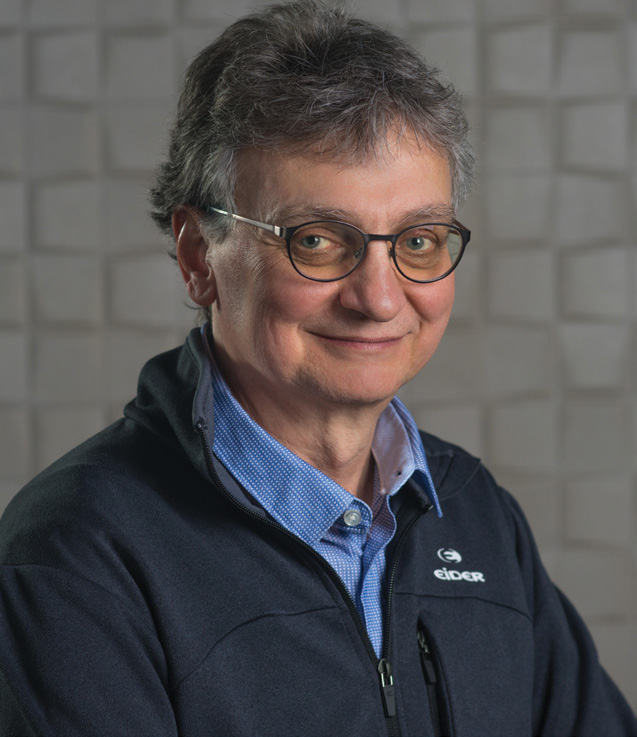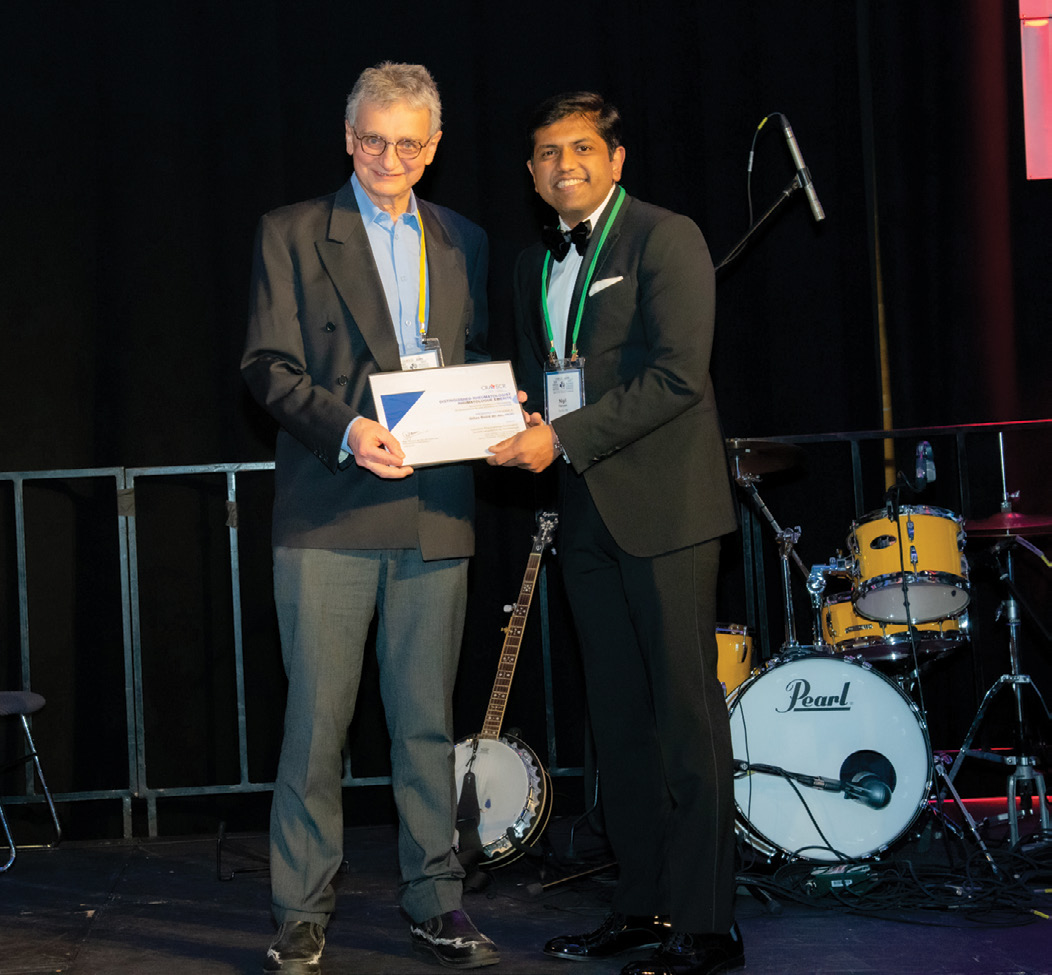Summer 2023 (Volume 33, Number 2)
The CRA's 2023 Distinguished
Rheumatologist: Dr. Gilles Boire
Download PDF

Why did you become a rheumatologist?
What or who influenced you along the
way to do so?
The choice of rheumatology gradually
became clearer during my core medicine
residency. I had chosen medicine
because I wanted to help people, but I
also wanted to help improve patient
care, if possible. At the time, rheumatology
was a specialty with two common
treatments (non-steroidal anti-inflammatory
drugs [NSAIDs] and corticosteroids),
with the occasional addition of
hydroxychloroquine, gold salts and, rarely,
cyclophosphamide. It was therefore
essential to develop strong relationships
with patients and to learn to listen to
them to help them, if not to cure them.
It was also the time of the discovery of acquired immunodeficiency
syndrome (AIDS). Clearly, we were so ignorant
of how the immune system worked that there would soon be
great advances in the field. Since rheumatological diseases
obviously involved a disruption of the immune system, the
future looked bright. Although I was born well before Generation
Y, I had to consider that my wife was also a physician
and that we already had two young daughters, so I needed a
career with a predictable schedule. Rheumatology therefore
offered the advantages of being relatively uncharted territory,
but also of being less focused on hospitalized patients.
But it was during my internship with Dr. Henri Ménard that
things really clicked. The patients were suffering, and their
doctors did not understand why. And then came Dr. Ménard
who questioned, palpated, did some tests, and drew conclusions.
The ability to make a diagnosis from seemingly unrelated
elements appealed to me. Then Dr. Ménard and I prepared
a first abstract that was submitted and accepted by the
American College of Rheumatology (ACR). My passion for
research was launched. And the advances in rheumatology
and in research exceeded my wildest expectations.
Your major research interests include autoimmunity,
in particular the Ro/hY RNA complex, improving
first-line care of fragility fracture patients, and early
prognostic classification of patients with recent onset
inflammatory arthritis.
Can you tell us about the development of the Early
Undifferentiated PolyArthritis (EUPA) cohort as well as
the Biobank of Immune and Inflammatory Diseases and
Disorders and the “University of Sherbrooke Registry of
Advanced Therapies” that facilitate
personalized approaches for the
treatment of these patients?
My research career can be divided into three
phases. The first phase was wet-laboratory
oriented, focusing on my favorite
autoantigen, the Ro ribonucleoproteins,
targeted by anti-Ro (SS-A) antibodies.
We studied antibodies and antigens in
several ways: first with the tools I had
learned during my postdoctoral fellowship
at Yale University, and then with
the help of colleagues in Sherbrooke.
Some of our work from the 1990s is
still cited regularly. Then, we crossed
paths with Ms. Savoie. The discovery of
anti-Sa (citrullinated vimentin) in the
serum of this patient reoriented me towards
clinical research, and in particular cohorts of patients,
specifically with polyarthritis of recent onset (EUPA cohort).
The principles underlying EUPA were clear: 1) without accurate
and thorough phenotyping, biomarkers are useless; 2)
long-term longitudinal follow-up is essential to properly define
clinical outcomes; and 3) scientific knowledge evolves
rapidly and in unpredictable directions. It is therefore crucial
to have quality data matched to stored serialized biospecimens
to allow for the study of new biomarkers, or the use
of new analytical methods that we could not even dream of
at the time of their collection. The EUPA patient specimens
have now been analyzed by different "-omics" (genomics,
microRNAmics, proteomics). Hence the third phase, the
development of the Biobank of Immune and Inflammatory
Diseases and Disorders, initially focused on the EUPA cohort.
Thanks to recent legislative progress concerning clinical
research, the Biobank is now dedicated to all aspects of
rheumatology, from autoinflammation to autoimmunity,
and from serum to synovial and salivary biopsies, including
synovial fluid.
One of the most important conundrums in rheumatology
is the heterogeneity of response to treatments. Our
somewhat eccentric geographic location allows for prolonged
follow-up of most of our patients. Moreover, the regional
organization of care means that all the hospital administrative
data of these patients can easily be combined
with clinical information, leading to the development of
our University of Sherbrooke Registry of Advanced Therapies
(USRAT). We have linked our biobank with USRAT to
better define the biological or psychosocial characteristics
underlying treatment failure.

Dr. Gilles Boire receiving his award from CRA President
Dr. Nigil Haroon at the CRA Annual Scientific Meeting in
Quebec City, which took place in February 2023.
In addition to running a busy clinic and assuming several
administrative duties, you have supervised 20 graduate and
postgraduate students as well as 27 rheumatology fellows,
5 of whom are still in training. What are your thoughts on
teaching?
One of my greatest satisfactions during my career has been
my involvement in teaching at all levels within the medical
school. This included mentoring at the undergraduate level
for general training of medical students, at the postdoctoral
level teaching rheumatology basics to pediatric and core
medical residents and training new rheumatologists, and
at the postgraduate level training immunology and clinical
scientists. Many of my former graduate students are now
academic or industry researchers. Rheumatologists who graduated
from the Sherbrooke program now represent nearly
20% of all rheumatologists in Quebec. I am pleased to have
been able to facilitate their positive contribution to Quebec
and Canada today.
Can you tell us about other adult cohorts that you have
contributed to (CATCH; BIODAM) and pediatric (REACCHOut;
BBOP) cohorts?
From the very beginning, I had a high clinical interest in
treating children with rheumatologic disease. I was initially
responding to a local clinical need as there was no other
rheumatologist available to treat children with arthritis. But
it also allowed me to see how rudimentary the treatment
of children was at the time. I quickly became interested in
participating and contributing to pediatric research projects.
I got to know some outstanding researchers (Ciaran
Duffy, Jaime Guzman, Rae Yeung and Alan Rosenberg,
among others) from whom I learned a great deal. These researchers
have developed a world-class pediatric rheumatology
research network that has truly improved the treatment
of children with rheumatic diseases. In comparison, adult
rheumatologists are disorganized and would greatly benefit
from the pediatric networking experience.
As a result of the development of the EUPA cohort infrastructure,
I was able to join other adult clinical research
efforts, in particular the CATCH cohort led by Vivian Bykerk
and the BIODAM project of Walter Maksymowych. Thanks
to the existence of our EUPA cohort, we have been able to
contribute significantly to these research projects. The results
of these extremely productive collaborations have constituted
a significant proportion of my publications.
Gilles Boire, MD, MSc, FRCPC
Rheumatologist,
Department of Medicine,
Faculty of Medicine and Health Sciences,
Université de Sherbrooke
Centre intégré universitaire de santé et de services
sociaux de l’Estrie – Centre hospitalier universitaire
de Sherbrooke (CIUSSS de l'Estrie- CHUS)
Sherbrooke, Québec
|
